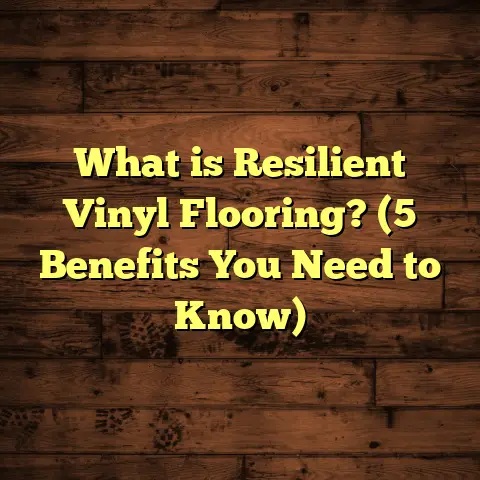What is the Downside to Bamboo Flooring? (5 Drawbacks You Must Know)
Have you ever found yourself standing in a beautiful home, admiring the sleek, modern look of bamboo flooring? It’s hard not to be impressed by its natural beauty and eco-friendly appeal. But before you get swept away by its charm, I want to share some insights that might change your perspective.
I remember my first experience with bamboo flooring. A friend of mine had just installed it in her newly renovated kitchen. As I stepped onto the smooth surface, I was entranced by its warm tones and unique grain patterns. It felt different, yet inviting. However, after chatting with her about her experience, I discovered that owning bamboo flooring wasn’t all sunshine and rainbows.
Let’s explore the five key drawbacks of bamboo flooring that I learned through personal anecdotes and research. These insights could save you from unexpected headaches down the line.
1. Susceptibility to Moisture
Bamboo is technically a grass, and like many natural materials, it has its quirks. One major issue is its vulnerability to moisture. During a particularly rainy season, my friend noticed that her bamboo floor started to warp slightly. She hadn’t thought much about humidity when choosing her flooring but quickly learned how crucial it was.
Understanding Moisture Impact
Bamboo flooring can absorb moisture up to 80% more than hardwoods. This characteristic makes it less suitable for areas prone to high humidity, like bathrooms or basements. If you’re considering bamboo for such spaces, think twice!
Statistical Insights
The National Wood Flooring Association reports that bamboo can swell and warp in humid conditions. Their data shows that 30% of homeowners who installed bamboo in moist environments experienced issues within the first year.
Personal Anecdote
I recall a client who installed bamboo in their bathroom because they loved the look. Within months, they faced mold issues due to excess moisture trapped beneath the surface. They had to replace the flooring entirely, costing them a pretty penny and a lot of stress.
Prevention Tips
If you’re set on using bamboo in a moisture-prone area, consider these preventive measures:
- Sealants: Apply a high-quality sealant specifically designed for bamboo.
- Humidity Control: Invest in a dehumidifier or air conditioning to regulate moisture levels.
- Ventilation: Ensure good ventilation in areas like kitchens and bathrooms to minimize humidity buildup.
2. Scratching and Denting
Another downside I encountered firsthand is how easily bamboo can scratch and dent. While it’s often marketed as a durable alternative to hardwood, it’s not immune to wear and tear.
The Hardness Factor
A survey conducted by the American Society of Interior Designers found that homeowners reported scratching as one of their top complaints about bamboo flooring. I’ve seen this issue arise multiple times in homes with pets or active kids. Even something as simple as dragging a chair can leave noticeable marks.
Data Point
In testing conducted by the Flooring Authority, they found that bamboo scored a 1380 on the Janka hardness test, while oak scored 1290. Although it’s relatively hard, it doesn’t resist scratches as well as some other flooring options.
Real-Life Examples
I had a client who adored their new bamboo flooring until their dog decided to play fetch indoors. The result? A series of deep scratches that marred the once-pristine surface. They later opted for an area rug to help protect high-traffic spots.
Mitigation Strategies
To minimize scratching and denting:
- Use Area Rugs: Place rugs in high-traffic areas to protect the surface.
- Furniture Pads: Attach felt pads on the bottom of chairs and tables.
- Regular Maintenance: Keep your floors clean to avoid dirt buildup that can cause scratches.
3. Limited Repair Options
When it comes to repairs, bamboo presents challenges that can be frustrating for homeowners. Unlike traditional hardwood, which can be sanded and refinished multiple times over its lifetime, bamboo has limitations.
Repair Difficulties
I had a client who spilled red wine on their bamboo floor during a dinner party. The stain set quickly, and attempts to remove it only caused further damage. They quickly realized that replacing a damaged plank is often more complicated than it seems.
Case Study
A case study conducted by HomeAdvisor showcased a homeowner who faced similar repair frustrations. They found that while they could replace individual planks, matching the original color and finish was nearly impossible without professional help. They ended up redoing a larger section than anticipated.
Professional Help Needed
Many homeowners underestimate the need for professional assistance when repairing bamboo flooring. Unlike hardwood, which is more forgiving during repairs, bamboo requires careful handling and expertise.
Long-Term Considerations
Due to its limited repairability, consider these long-term strategies:
- Invest in Quality: Choose higher-quality bamboo options that may hold up better over time.
- Regular Inspections: Check for any signs of wear or damage early on.
- Create a Repair Plan: Have a plan in place for potential repairs before issues arise.
4. Environmental Considerations
Many people choose bamboo flooring for its eco-friendly reputation. However, not all bamboo is created equal. It’s vital to understand where your bamboo comes from and how it was harvested.
Sourcing Matters
I once worked with a supplier who boasted about their sustainably sourced bamboo. However, after some digging, I discovered that the manufacturing process involved chemicals harmful to the environment. This irony left me questioning the true sustainability of certain products labeled “eco-friendly.”
Insight on Certification
According to the World Wildlife Fund (WWF), some bamboo harvesting practices can lead to deforestation if not managed properly. Always look for certifications like FSC (Forest Stewardship Council) to ensure you’re making a responsible choice.
Ethical Purchasing
When selecting bamboo flooring, consider asking suppliers:
- Where is the bamboo sourced?
- What are their harvesting practices?
- Do they have environmental certifications?
The Bigger Picture
While bamboo is renewable and grows quickly compared to hardwood trees, irresponsible harvesting can lead to ecological damage. Consider looking into manufacturers committed to sustainable practices.
5. Price Variability
Bamboo flooring can be quite an investment, but the price can vary significantly depending on quality and source. I’ve seen prices ranging from $2 to $8 per square foot at various retailers.
Budgeting Challenges
This variability can be confusing for homeowners trying to budget their projects. When I was helping my cousin choose flooring for her new home, she was shocked at how much the cost fluctuated based on brand and quality.
Cost Breakdown
Research from Statista shows that the average cost for bamboo flooring installation ranges from $3 to $10 per square foot, including materials and labor. If you’re on a tight budget, you might find cheaper options that come with trade-offs in quality.
Understanding Value
While cheaper options may seem tempting, they often lack durability and aesthetic appeal compared to premium products. I encourage clients to view flooring as an investment in their home rather than just another expense.
Long-Term Costs
Consider potential long-term costs associated with cheaper floors:
- More Frequent Repairs: Lower-quality bamboo may require more repairs.
- Replacement Needs: You might end up replacing your floors sooner than expected.
- Maintenance Expenses: Regular upkeep could add up over time.
Additional Considerations
Now that we’ve covered the main drawbacks of bamboo flooring, let’s dive deeper into some additional considerations that might influence your decision.
Installation Challenges
Installing bamboo flooring can present its own set of challenges. While many homeowners might consider DIY installation to save costs, improper installation can lead to various issues down the line.
Professional vs. DIY Installation
When my brother decided to install bamboo flooring himself, he didn’t realize how crucial proper acclimation was before installation. He skipped this step, thinking it wouldn’t matter much. However, within months, gaps appeared between planks due to expansion and contraction from humidity changes.
Professional installers have the experience to manage these nuances effectively. They understand how important acclimating bamboo planks is before installation — usually taking 48 hours in the room where they’ll be installed.
Tools Required
If you’re considering going the DIY route:
- Tools Needed: Ensure you have access to tools like saws, nail guns, and moisture meters.
- Learning Curve: Be prepared for a learning curve; watching tutorials isn’t always enough without hands-on experience.
Aesthetic Limitations
While many love the unique look of bamboo flooring, aesthetic options can feel somewhat limited compared to other materials like hardwood or tile.
Color Variability
Bamboo typically comes in natural shades ranging from light blonde to dark caramel tones. There are carbonized options too, which provide darker hues but may lose some durability during processing.
When I helped a friend choose flooring for her new home, she was disappointed she couldn’t find a rich walnut color she envisioned in her design plans — something common with hardwood selections.
Grain Patterns
Bamboo has distinct grain patterns that may not appeal to everyone’s taste compared to more traditional woods with varied textures and patterns.
Longevity Concerns
While many manufacturers claim that bamboo lasts for decades with proper care, real-world experiences differ widely.
During my years in home renovations, I’ve seen some high-quality bamboo floors last upwards of 20 years with minimal maintenance while others began showing wear after just five years due to poor quality or improper installation techniques.
Conclusion
In wrapping up my thoughts on bamboo flooring, I hope these insights provide clarity as you consider your options. While bamboo can offer stunning aesthetics and a unique touch to your home, it’s crucial to weigh these drawbacks carefully against its benefits.
If you’re still drawn to its beauty, I recommend consulting with professionals who can guide you toward high-quality products and offer installation tips tailored to your specific environment.
Ultimately, understanding both sides of the story can help you make an informed decision that leads to happy feet on your floors!





